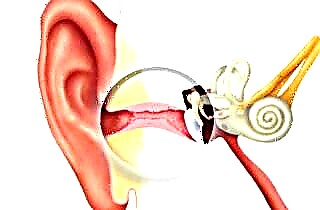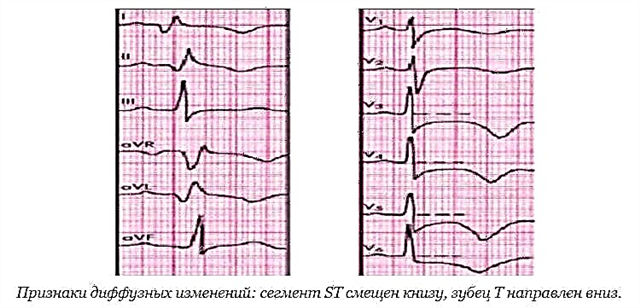Ear myringitis is an inflammation of the tympanic membrane that often develops as a result of a viral infection. Moreover, it can be provoked by bacteria or other microorganisms. Myringitis is rarely primary, often accompanying inflammatory processes in the external auditory canal and middle ear. Sometimes the disease can be the result of pneumonia or the result of thermal and chemical influences.
Diagnosis, symptoms and pathogenesis of myringitis
 It is difficult to separate the symptoms of inflammation of the tympanic membrane from the accompanying symptoms of diseases of the middle and outer ear, since the myringa infection (tympanic membrane) rarely acts as a focus of the spread of infection. This can happen, for example, in the event of a traumatic injury. An isolated inflammatory process also occurs with measles, flu, pneumonia. Moreover, more often (although not always), myringitis becomes a consequence of a spread infection - from the outer and middle ear to the eardrum. This relationship is due to the location of the miringa between the middle and outer ear, as well as its structure: the outer surface is a continuation of the epidermis of the auditory canal, and the inner, from the side of the middle ear, is the mucous membrane, which deprives this organ of isolation.
It is difficult to separate the symptoms of inflammation of the tympanic membrane from the accompanying symptoms of diseases of the middle and outer ear, since the myringa infection (tympanic membrane) rarely acts as a focus of the spread of infection. This can happen, for example, in the event of a traumatic injury. An isolated inflammatory process also occurs with measles, flu, pneumonia. Moreover, more often (although not always), myringitis becomes a consequence of a spread infection - from the outer and middle ear to the eardrum. This relationship is due to the location of the miringa between the middle and outer ear, as well as its structure: the outer surface is a continuation of the epidermis of the auditory canal, and the inner, from the side of the middle ear, is the mucous membrane, which deprives this organ of isolation.
The development of the disease goes through several stages:
- The initial stage of inflammation is characterized by the manifestation of dilating vessels on the surface of the myringa, mainly around the short process.
- Hyperemia develops - the overflow of blood vessels with blood, as a result of which the contours are smoothed out and slightly protrude, edema of the tympanic membrane occurs.
- On the surface of the organ, bubbles filled with pus or blood may form, upon opening of which serous or bloody discharge appears. These bubbles usually burst on their own. If a single large bladder matures, it may, upon visual inspection, resemble a protrusion of myringi with middle ear exudate, which leads to diagnostic errors during otoscopic examination. And a slight discharge from the bubbles that have opened on their own resembles the symptoms of inflammation of the middle ear.
Depending on the type of myringitis, some of the symptoms may vary:
- Hemorrhagic. With the flu, a few days after its onset, a hemorrhagic or bullous form of the disease may develop. The disease is characterized by the development of several flikten (millet pimples). Bullae appear on the surface (with spreading into the external auditory canal), which contain hemorrhagic fluid. This is accompanied by hearing loss, pain and bleeding.
 Spicy. In case of an acute illness, there may be a slight hearing impairment with a small noise, heaviness in the ears. But sometimes the intensity of pain increases so much that the patient cannot fall asleep due to boring pains. The body temperature often remains within the normal range, however, with influenza inflammation, it can increase significantly. Acute myringitis often develops into a chronic form.
Spicy. In case of an acute illness, there may be a slight hearing impairment with a small noise, heaviness in the ears. But sometimes the intensity of pain increases so much that the patient cannot fall asleep due to boring pains. The body temperature often remains within the normal range, however, with influenza inflammation, it can increase significantly. Acute myringitis often develops into a chronic form.- Chronic. In addition to the previous acute form, the cause of the disease can be diffuse inflammatory processes in the ear canal and eczema. The surface of the miringi becomes soaked under purulent discharge and thickens. An unpleasant odor is produced. The color changes - from gray-pink on a smooth surface (normal) to dirty gray with scales of peeling epidermis and roughness. If granules are formed on myring, then they can gradually spread over the entire surface and lead to its destruction. This form of the disease, as a rule, leads to damage to the external auditory canal. However, pathological changes can be limited only by severe itching, a feeling of heaviness and mild dullness of hearing. Therefore, patients often go to the doctor, already when the foul-smelling discharge from the ear begins.
The variability and similarity of symptoms leads to diagnostic difficulties. The otoscopic picture does not always exclude otitis media. An isolated lesion of the miringa is evidenced by the undisturbed patency of the Eustachian tube, which is determined by the blowing method. However, laboratory tests are added to this method in order to determine the pathogen.
When diagnosing chronic inflammation of the membrane, attention is paid to the preservation of its mobility, the absence of perforation noise when blowing, and an insignificant degree of hearing impairment. Chronic myringitis is more common than acute myringitis and poses a danger not only by the difficulties of diagnosis, but also by the difficulties that arise during treatment. Slot machines for money have become a real boon for some gamblers. How best to choose an emulator, what a beginner gambler should pay attention to and how not to lose a large amount of money in excitement is written here. Visit the casino website and start winning money right after a quick registration procedure! Working with money, withdrawing winnings and all other operations are completely safe.
Myringitis treatment
 Treatment of the disease begins with the elimination of the causes of the inflammation. In the influenza form, anti-influenza drugs are prescribed in parallel with anti-inflammatory (topically). Pain relievers are used if necessary.
Treatment of the disease begins with the elimination of the causes of the inflammation. In the influenza form, anti-influenza drugs are prescribed in parallel with anti-inflammatory (topically). Pain relievers are used if necessary.
Treatment of chronic inflammation of the tympanic membrane is difficult and requires persistence and a long period:
- scales of the epidermis are regularly removed,
- 2% boric alcohol or lapis, 3% resorcinol solution is poured into the ear canal,
- granulations covering the surface are cauterized with a 10% solution of lapis,
- boric acid powder is blown into the ear canal, which gives one of the most noticeable healing effects.
Systemic measures and persistence lead to complete healing.
In the acute form, in addition to eliminating the cause of the disease, a 2-3% solution of carbolic glycerin is injected. If the doctor has the appropriate competence, the bubbles formed on the surface are opened with a paracentesis needle, but the doctor must be very careful not to damage the myring and not cut its thickness.
In case of profuse discharge, a strip of gauze or a gauze swab is inserted into the ear canal. The cure of the acute form of the disease with appropriate treatment occurs in a few days.

 Spicy. In case of an acute illness, there may be a slight hearing impairment with a small noise, heaviness in the ears. But sometimes the intensity of pain increases so much that the patient cannot fall asleep due to boring pains. The body temperature often remains within the normal range, however, with influenza inflammation, it can increase significantly. Acute myringitis often develops into a chronic form.
Spicy. In case of an acute illness, there may be a slight hearing impairment with a small noise, heaviness in the ears. But sometimes the intensity of pain increases so much that the patient cannot fall asleep due to boring pains. The body temperature often remains within the normal range, however, with influenza inflammation, it can increase significantly. Acute myringitis often develops into a chronic form.

